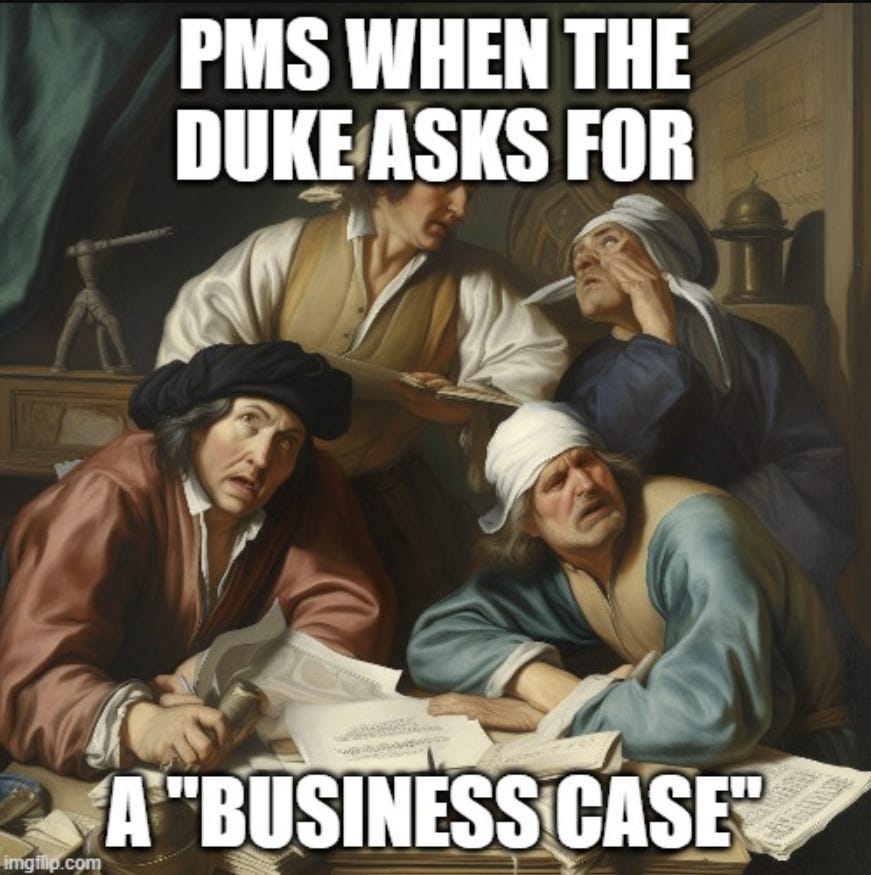The Math Behind Justifying Your Product & Growth Team’s Existence
Why "Breaking Even" is not enough
You could be sponsoring this post: 👉 sponsoring@productea.io for a Media Kit
Let’s cut to the chase: If your product team isn’t generating 3–5x its cost annually, you’re operating at a loss. You probably don’t want to be doing that, especially as the industry is now looking for Growth and Product Managers who understand that.
Most PMs and CPOs wildly underestimate this number (if they think about it at all). Here’s why and how to fix it.
Content:
Why breaking even isn’t enough
The CEO’s Spreadsheet Doesn’t Care About “Effort”
Why Missing Deadlines Erode Value (Even If You Deliver But Too Late)
Case Study: The Reporting Dashboard That Saved a Quarter
Actionable Takeaways
(Paid) Cheatsheet & Glossary for Junior PMs
(Paid) Transcript to use with an LLM
Why “Breaking Even” Isn’t Enough
Most product managers, when prompted, assume that justifying their team’s cost means generating 1.5x or 2x their cost. Wrong. Let’s break it down:
Team Cost: A typical 5–10 person team (common in Series A–D companies) costs ~$1M/year in salaries, overhead, and management.
Failure Rate: 50–70% of product ideas fail. Even “good” PMs see more than half of their bets flop.
Survival Math: To offset failures, your successful ideas must cover both the wins and losses. Example:
Cost: $1M/year
Success Rate: 50% (This is still optimistic, but let’s keep it simple)
Required Revenue: $2M per year just to break even. $3–5M to be valued.
Most teams miss this because they ignore the hidden cost of failure.
The CEO’s Spreadsheet Doesn’t Care About “Effort”
I’ve seen PMs argue, “But this is the best idea we have!” If that “best idea” can’t plausibly generate $1M/quarter, you’re gambling with your team’s future. Where do you think a CFO / CEO in difficult times will go look for money?
Growth Teams: Easier to measure (e.g., trial conversions, activation rates).
Product Teams: Focus at least conceptually on churn reduction. Example:
If 10% of churn is due to a missing feature,
Solving it retains X customers/month,
Compounding to $Y annually.
I will talk about managing churn in some upcoming articles, but just remember for the moment: If you have no idea how to do anything, kick uncle churn in the butt. Always works. For investors, CEO’s, CRO, and even Gary from Sales understands that.
Why Missing Deadlines Erode Value (Even If You Deliver But Too Late)
Another good reason to aim really high is our habit of missing deadlines:
Let’s say your team promises a customer segmentation feature to reduce churn, estimating a 3-month build for a $250k cost (aligned with the $1M annual budget). But delays stretch it to 6 months. Here’s the math:
Cost Doubles: The project now consumes $500k (half the annual budget).
Revenue Stagnates: Even if successful, the upside remains ~$750k (3x the original $250k target).
Brutal Outcome: You spent $500k to generate $750k - a 1.5x return, below the survival threshold.
Missed deadlines don’t just frustrate stakeholders - they halve your ROI and turn viable ideas into financial liabilities. Teams that chronically overshoot timelines become net negative assets, regardless of output quality.
Case Study: The Reporting Dashboard That Saved a Quarter
Let’s take a real-world example. Suppose your team proposes a custom reporting dashboard to reduce churn. Here’s the math:
Team Cost: $250k/quarter (from $1M annual budget).
Idea Upside:
Churn data shows 8% of customers leave due to lack of advanced analytics.
Solving this retains 120 customers/quarter (assuming 1,500 total customers).
With an ARPU of $2,000, that’s $240k/quarter retained.
Brutal Truth:
Even if successful, $240k only covers ~1x team cost.
To hit 3x, you need $750k/quarter - meaning three equally strong ideas must land simultaneously.
This is why PMs must kill small ideas and focus on big swings.
Actionable Takeaways
Size Ideas Ruthlessly: If an idea can’t hit 5x team cost (don’t forget to consider the time it takes to build) in upside, kill it.
CPOs: Bake failure rates into budget asks. A $1M team needs $3-5M outcomes.
PMs: Pitch churn-reduction bets first - they’re easier to quantify especially for feature teams.
Teams that grasp this math survive layoffs. Those who don’t? They become case studies in misaligned priorities.
Want to discuss this article with others and me? Join the paid subscribers in my chat.
For Paid Subscribers Only: The “Survival Math” Cheat Sheet & Glossary & LLM Text Sheet
(Exclusive to supporters funding my caffeine addiction)



